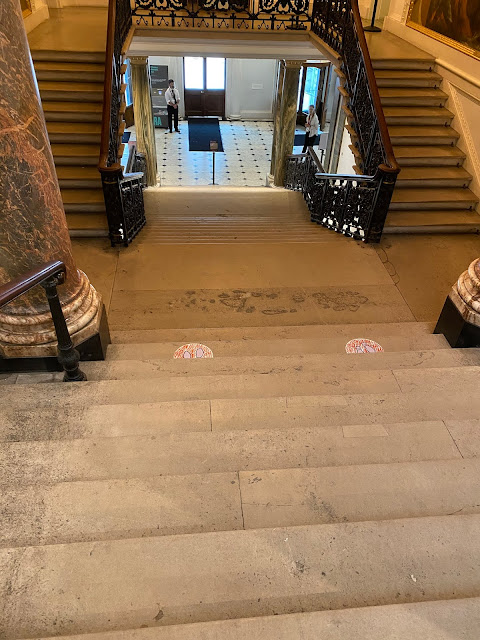At this time of year (August/September) the Royal Academy of Arts is usually bustling, if not bursting, with visitors to the Summer Exhibition of all-comers’ art, of all qualities and none. It’s not just an exhibition to be viewed- with reverence, excitement or raised eyebrows; it’s also a fair. The art is mostly for sale. Little red “sold” dots grow like pondweed under many of the works (especially the prints).
This year, the Summer Exhibition has been banished to the autumn, as The Academy slowly awakes from lockdown and cautiously stretches a corporate limb and blinks a corporate eye. In practical terms this has meant, since July, opening for a few days a week and for shorter hours on those days.
“Opening” means putting on exhibitions, of course. Although the Summer Exhibition has been kicked down the road to a time when more exuberant visiting will, we all hope, be permitted, more serious stuff has been continued or installed..
Lockdown paused a major exhibition of Picasso works. It had to end on schedule just a couple of weeks after reopening (endings of major exhibitions cannot on the whole be delayed: the various lenders want their works back on time).
However, the RA has been extremely lucky with another exhibition planned for 2020. This is showing late French C19 painting from the Ordrugaard collection, originally the private collection assembled in the early C20 by an insurance magnate called Hansen, but now owned by the Danish State.
The exhibition, Gaugin and The Impressionists, was to run from the end of March (a few days after lockdown) to the middle of June (still in lockdown). So timing could not, in some respects, be worse. But a couple of things worked in the RA’s favour. First, the works had been shipped to London in anticipation of the scheduled opening. They were here before lockdown and, during lockdown, here they had to stay. Secondly, the works were on loan from one source – so negotiations about an extension were possible.
Result: a rescheduled Exhibition from early August to mid-October.
Visiting the RA in this interregnum between closure and full opening (or perhaps re-closure..) is a strange experience. I’m told that there’s a limit of 600 people allowed in the whole vast estate, in total, on any one day, the total including all staff and all visitors. So visitors are few at any one time, and booking is compulsory for all, including Friends and others usually entitled to free entry as they please. Indeed, any visit, whether or not to a paying exhibition, must be booked. There's a pop-up border checkpoint where everyone must show their credentials.
By contrast, there dozens of young attendants everywhere, masked or visored up, shepherding the sparse numbers of visitors at every step, from entrance, to corridors, into galleries and especially into toilets.. And, as the supply of visitors frequently dries up, they stand in knots amiably chatting to one another.
This seems to be a Summer Vacation job scheme par excellence, and in abundance.
The limits on numbers translates to super-distancing, and effectively renders the experience in the galleries on a par with a private view, and the overall experience of being in the RA’s huge buildings akin to that of trespassing after hours..
Gauguin just about justifies his lead billing in Gauguin and The Impressionists, although of the 60 paintings displayed, only 7 are by him. However, Hansen was especially keen on Gauguin, well known in Scandinavia because his wife, whom he abandoned for Tahiti, was Danish. She returned to Denmark with numerous Gauguin paintings that found their way into various collections, including Hansen’s.
The Gauguin work that drew my attention is the Portrait of a Young Girl, from the Tahiti period.
The intensity and contrast of the colours is remarkable; but the dissonance between the image of the girl as presented by Gauguin and her stated age at the time of sitting- 9 years- is somewhat creepy. But then creepiness is a feature of many of the paintings done in Tahiti.
There are lovely paintings by Sisley and Pissarro,
and two gems by Manet;
The latter is modelled by the woman who was to become Manet's wife. The tenderness is obvious. It is also one example among many of Manet's delight in reworking images or themes from earlier masters. Here, it's the typical Italian Renaissance composition of foregrounded classical pose with pastoral vista behind.
Another, more scandalous example (not in this Exhibition) is Manet's Olympia, a courtesan's pose directly descended from Titian and Goya.










No comments:
Post a Comment